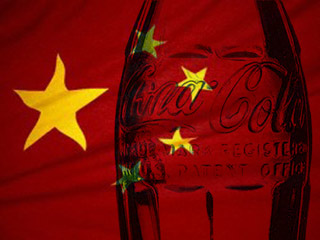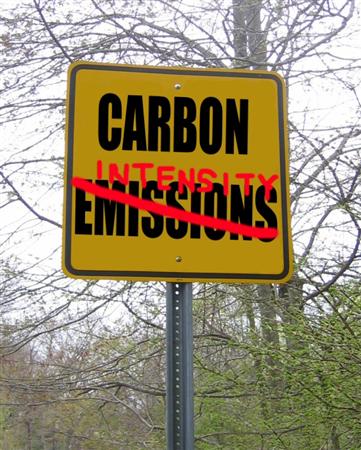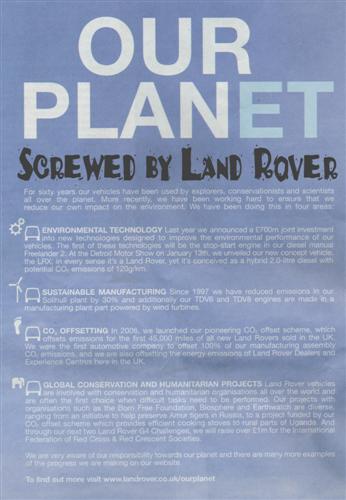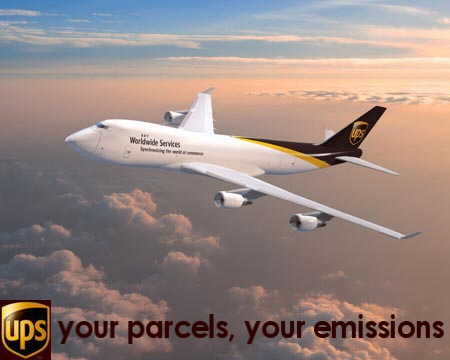
Can we really put the blame on UPS for having it’s own airport terminals, having a fleet of jumbo jets, and using air as the standard method of transporting packages around the world? Don’t decide yet; wait until the end of this little article.
Ok, here’s a quote from the UPS web site:
“Our comprehensive hub-and-spoke network provides you with access to key transportation centers across the U.S. and beyond. Our all-points international air hub is located in Louisville, KY, with other regional hubs located in strategic cities across the U.S. We cover the rest of the world, as well, by operating international air hubs in Miami, Hamilton, Cologne, Taipei, and the Philippines.”
And here’s another:
“On Monday, February 1, 1988, UPS operated the first two flights under its own aircraft operating certificate. Now, every hour of the day, 365 days a year, a UPS aircraft is flying somewhere in the world – moving packages and freight.”
Surely this is just part of the way things are. Watching Tom Hanks being the perfect courier, taking pride in his company’s performance in the movie “Castaway” (ok, so FedEx sponsored it, but you get the picture) warms the cockles of even the most cold-hearted sceptic. This is what UPS do, and have been doing at a faster and faster rate for 101 years.
Here are the hard facts:
1) UPS claim to be an environmentally responsible company. They have their own Sustainability pages and say:
“We conduct our business and operations with consideration for their environmental impact. Our responsibility for the environment ranges from the construction, maintenance, and operation of our facilities, to the maintenance and operation of our vehicles and aircraft, to the conservation of resources.”
2) UPS operate the world’s 9th (or possibly 8th) largest airline, comprising 268 owned aircraft and another 311 chartered, ranging from Boeing 727s to 747s in size.
3) In 2006 UPS’s USA freight emissions produced (according to UPS) 7.37 million tonnes of carbon dioxide equivalent (includes other greenhouse gases). This is about the same as the entire annual emissions for Honduras.
4) UPS do not publish their global aircraft emissions figures, instead they show the carbon intensity (the figure that companies and governments use when their overall emissions are going up). It is currently 0.81 kg of some kind of emissions – it doesn’t say what, but we have to assume it’s carbon dioxide – per tonne of cargo.
5) Extrapolating the figures from UPS’s own Worldwide Facts list; if you take the 1.8 million parcels and documents per day, average the weight at 500g (I’m being very conservative here), multiply by 365, you get 330,000 tonnes of air freight. This means that UPS produce an extra…hang on! This doesn’t make sense!
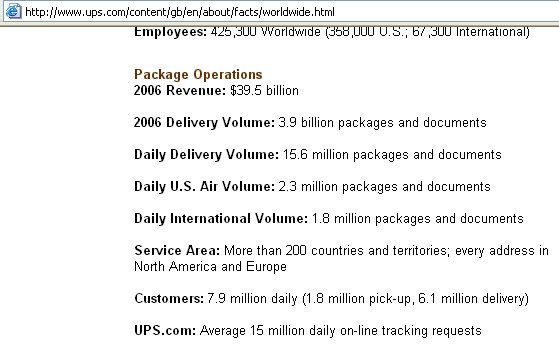
Dig a bit deeper, and you find that the carbon intensity figure is a complete fudge.
“UPS’s (U.S.) absolute CO2 emissions increased by 1% from 2003 to 2004.
However, UPS’s CO2 efficiency improved 2.8 percent. We produced .06 metric tonnes (60 kilograms)less CO2 emissions per 1,000 packages delivered than we did in 2003.” (http://www.cdproject.net/download.asp?file=CDP3_UPS_AQ_3453.pdf)
This means that, assuming the UPS figures are correct, 0.81 on their chart actually means 2.4 tonnes per 1000 packages. We can now use that figure to show that the 657 million international packages per year produces another 1.3 million tonnes of carbon dioxide.
Quite why UPS are so cagey about this figure I have no idea, but it suggests they are not quite so comfortable about their emissions as their environmental pages suggest. But, can we pin the blame on UPS for producing all these emissions?
Not quite. Businesses and increasingly individuals are demanding rapid transportation of goods around the world, and the companies that offer the quickest service are the companies who will get the lion’s share of the custom. UPS are responding to a global demand for rapid transport, and as a consequence of their size they have a lot of aircraft, a lot of trucks and a lot of vans. So, it appears that the businesses who want things NOW have driven the growth of UPS rapid transportation, which has driven the growth of the emissions from freight transport.
However, isn’t it UPS’s CEO who says: “The global trends…are creating compelling growth opportunities for UPS.”
UPS are loving their position in the market, and they will continue to transport things faster and faster, producing more and more emissions because it is good for business – their business.
Just to conclude, I had to include this little snippet, from the Carbon Disclosure Project:
“What renewable energy and energy efficiency activities are you undertaking to manage your emissions? ”
“Solar power provides 70 percent of the power needs at our Palm Springs, Calif., sorting facility. Since its deployment in July 2003, the 100 kilowatt solar panel initiative has produced over 523,000 kilowatt hours of energy, reducing our CO2 output by 1 million pounds. This is the equivalent of removing 99 passenger cars from the road for a year.”
Wow! 1 millions pounds, or 500 tonnes, or 0.0002% of their total USA emissions per year! Possibly the most pathetic statistic I have so far read in 2008.









